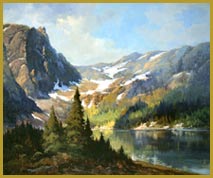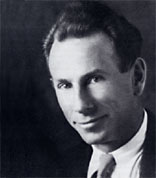|
Robert Wood in California
by Jeffrey Morseburg
Although Robert Wood did not settle in California until 1941, he painted in the Golden State as early as 1912. He made a series of sketching trips to California in the 1920s and 1930s when he was living in the Northwest and Texas. On these trips and from his sketches he painted a number of classic California subjects such as Santa Anita Canyon in the San Gabriel Valley, the Yosemite Valley, the High Sierras and scenes of Eucalyptus and golden poppies. These paintings can be distinguished from his later California work of the 1940s by the technique, signature and occasionally by dating.
Wood's technique of the 1930s and 1940s was usually softer and less stylized than the painters of the California Plein-Air movement. While it is difficult to describe the subtle and gradual changes in an artist's work in print, Wood's work of the 1930s was generally smoother and more detailed than his painting of the 1940s, perhaps more reminiscent of late-19th-century painters than his contemporaries. After he moved to California in 1941, his technique – especially in his mountain scenes – became more vigorous and he probably came under the spell of the Early California painters he admired. Artists like Edgar Payne and William Wendt were then in their last years and the California Plein-air movement was at the end of its era of popularity.
Wood moved from San Antonio to the art colony of Monterey in 1941, as WWII loomed. He lived there from 1941 to 1946, but painted very few classic California landscapes dueing his Monterey period, concentrating instead on mountain scenes, which were popular with his Midwestern and Eastern dealers.
Copyright 2003 Jeffrey Morseburg. Not to be reproduced without specific written permission.
|



